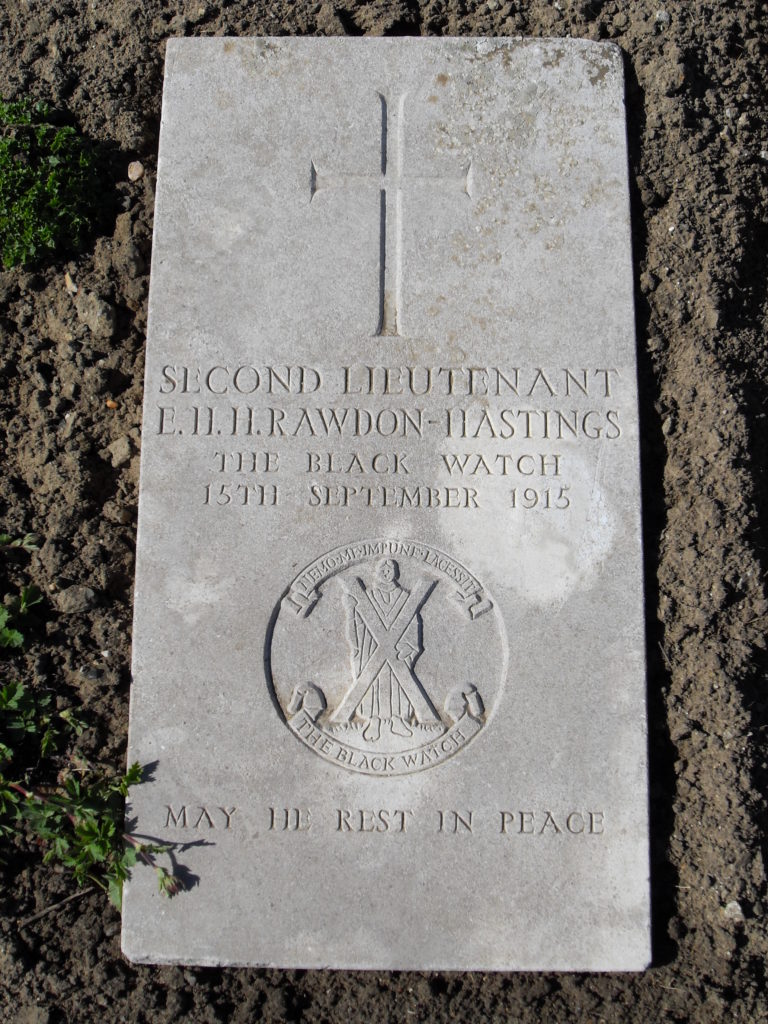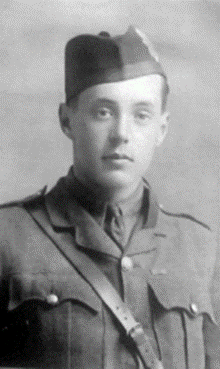Fact file:
Matriculated: 14 October 1913
Born: 31 August 1895
Died: 15 September 1915
Regiment: The Black Watch (Royal Highlanders)
Grave/Memorial: Wimereux Communal Cemetery; Grave 3.0.1
Family background
b. 31 August 1895 at Old Parks, Ashby-de-la-Zouch, Leicestershire. Second son of the Hon. Paulyn Francis Cuthbert Rawdon-Hastings (né Abney-Hastings; Rawdon-Hastings by Royal Licence from 1887) (1856-1907), son of the 1st Baron Donington, and Lady Maud Rawdon-Hastings (née Lady Maud Grimston) (1857-1929), the fifth child of James Grimston (1809-95), the 2nd Earl of Verulam, (m. 1881). At the time of the 1901 Census the family lived at Old Park House, Ashby de la Zouche, Leicestershire (7 servants); at the time of the 1911 Census Lady Maud was living in The Manor House, Ashby-de-la-Zouch, Leicestershire (8 servants). The family also lived at 14, Stafford Mansions, Buckingham Gate, London SW1.
Parents and antecedents
The Earldom of Loudoun (together with the subsidiary title Lord Tarrinzean and Mauchline) was a Scottish peerage created in 1633. In the nineteenth century, it passed to Edith Maud Abney-Hastings (1833-74), the elder daughter of the 2nd Marquess of Hastings. Her eldest son, Charles Edward Hastings Abney-Hastings (1855-1920), became the 11th Earl of Loudoun, and as he died without children, the title should have passed via his younger brother to his nephew Paulyn Charles, the elder brother of Edward Hugh. But because of their deaths, it passed in 1920 to his niece, Edith Maud, Edward Hugh’s oldest sister, who then became the 12th Countess of Loudon in her own right. In late 1920, the new Countess and her younger sister (who had become Viscountess St Davids in 1918), petitioned the Committee of Privileges of the House of Lords for the following ancient English baronies: Hungerford, de Moleyns, Strange de Knockyn, Botreaux, Stanley and Hastings (de Hastings) and Hastings (de Hungerford). In the following year the first three were granted to the Viscountess and the next three were granted to the Countess.
Siblings and their families
Brother of:
(1) Edith Maud [Abney-Hastings] (1883-1960) (after her marriage [1916] to [i] Captain Reginald Mowbray Chichester Huddlestone, MC [1894-after 1970], her husband assumed the surname of Abney-Hastings by Royal Licence [1918]), 6 children, marriage dissolved in 1947);
(2) Elizabeth Frances [Abney-Hastings] (1884-1974) (later Philipps when she became the second wife [1916] of John Wynford Philipps [later 13th Baronet Philipps (1912) and 1st Viscount St David’s (1918)], [1860-1938]), 2 children),
(3) Flora Anne [Abney-Hastings] (1885-1950);
(4) Isabel Jacqueline (1887-1917) (later Rostron after her marriage [1916] to [i] Captain Hubert James Cecil Rostron [1875-1926]); and
(5) Paulyn Charles James Reginald (1889-1915); killed in action on 13 October 1915, aged 25, while serving as a Captain with the 1/5th Battalion, the Leicestershire Regiment, part of the 138th Brigade in the 46th Division).
Paulyn Charles studied at Christ Church, Oxford, and was awarded a 3rd in Modern History in 1912. He was killed in action near the second German line leading ‘A’ Coy of his Battalion in a desperate bayonet charge against the left flank of the extremely well-fortified Hohenzollern Redoubt at Auchy-les-Mines, near Loos-en-Gohelle, on the last but one day of the Battle of Loos (25 September – 14 October 1915). On that day alone, 3,643 Allied soldiers were killed when trying to take the Redoubt, many during the first few minutes of the fighting due to well-positioned bomb-throwers and machine-guns. Paulyn Charles’s Battalion alone lost 226 officers and and men, and at the end of the day, the ground in front of the Redoubt was covered with the dead and wounded. With no known grave, his name is inscribed on the Loos Memorial.
“At Eton he did not rise to any position of special distinction, but, naturally a boy of reticent and retiring disposition, he did his duty quietly and unassumingly”.
Education
Rawdon-Hastings attended Wixenford Preparatory School, Wokingham, Berkshire from 1905 to 1909 and Eton College from 1909 to 1913; he was also awarded the George V Coronation Medal for acting as a page to his uncle, the 11th Earl of Loudoun. He matriculated at Magdalen as a Commoner on 14 October 1913, having taken Responsions in Hilary Term 1913. He took one half of the First Public Examination (Literature) in Trinity Term 1914 and at the end of that term he left without taking a degree in order to become a Regular officer in the Army. His Eton obituarist comments: “At Eton he did not rise to any position of special distinction, but, naturally a boy of reticent and retiring disposition, he did his duty quietly and unassumingly.”
War service
Although Rawdon-Hastings’s health was not strong, on leaving Magdalen, he went to the Royal Military Academy, Sandhurst, where, on 23 December 1914, he obtained a Regular Commission as Second Lieutenant in the family regiment, The Black Watch (Royal Highlanders), a Regt that was composed nearly entirely of Scotsmen. When war was declared, the 2nd (Regular) Battalion was stationed at Bareilly, in the Uttar Pradesh province of northern India. It sailed from Karachi on 21 September and, travelling via the Suez Canal, disembarked its 24 officers and 934 Other Ranks at Marseilles on 12 October 1914 as part of the 21st (Bareilly) Brigade, the 7th (Meerut) Division, IV (Indian) Corps (cf. Girdlestone [19], Cable [29] and Villiers [145]). It fought in the Battle of Ypres (23 November 1914) and the Battle of Neuve Chapelle (10-13 March 1915), when it lost 9 officers and 158 Other Ranks. On the afternoon of 9 May 1915, the first day of the Battle of Aubers Ridge, the Battalion took part in the third major assault on Aubers Ridge that day – over the same gound and using the same tactics as the first attacks in the morning. The Bareilly Brigade was on the left of the attack, which began at 16.00 hours, and although the Battalion’s Lance-Corporal David Finlay won the VC, it incurred heavy losses: 269 men, i.e. 50- 60% of those who had gone over the top – killed during the first few minutes. One of the observers of the Battle was Captain (later Major-General Sir) Percy Hobart (1885-1957), the controversial expert on armoured warfare during World War Two who, after being dismissed from the Army in 1940 and reinstated a year later thanks to Churchill’s personal intervention, was responsible for developing a range of specialist assault armour, known as Hobart’s Funnies, after being shocked by the appalling human waste that was occasioned by the tactics of Britain’s leading Generals during World War One.
Rawdon-Hastings arrived in France in May 1915, presumably as a replacement officer, and joined the 2nd Battalion on 7 June 1915, three months after Gilroy’s (76) younger brother had been killed while serving with it and when it was resting in billets between Le Touret and Lacouture, a couple of miles north-west of Festubert. The Battalion saw little action from June to early September, even when it was in reserve at La Gorgue or in the trenches near Richebourg St Vaast (2-13 July), south-east of Rue-de-Bacquerot (14-22 July), and elsewhere (30 July-16 August and 23 August – 1 September 1915). The Battalion’s War Diary does not record when Rawdon-Hastings fell ill, but according to his personal file he was admitted on 4 September 1915 to No. 14 Stationary Hospital, Wimereux, with suspected enteric fever that he had contracted while on active service, probably from contaminated food or stagnant water such as is to be found in waterlogged trenches. He died in the same hospital, aged 20, of Paratyphoid B, another name for enteric fever, on 15 September 1915. His mother was allowed to visit him during his illness and he is buried in Wimereux Communal Cemetery; Grave 3.0.1; inscribed: “May he rest in peace”. A well-attended memorial service was held for him and his elder brother in St Helen’s, the parish church of Ashby-de-la-Zouch, on 27 October 1915. He left £266.

Wimereux Communal Cemy; Grave 3.0.1.
The gravestone is flat because Rawdon-Hastings’s grave is on a cliff top by the sea, and if the gravestone were vertical, it would suffer from the salt air and the sea winds.
Bibliography
For the books and archives referred to here in short form, refer to the Slow Dusk Bibliography and Archival Sources.
Printed sources:
[Anon.], ‘Soldiers Who Have Fallen for King and Country’, Dundee Evening Telegraph, no. 4,953 (22 September 1915), p. 4.
[Anon.], ‘E. H. H. Rawdon-Hastings’ [obituary], The Eton College Chronicle, no. 1,544 (14 October 1915), p. 896.
[Anon.], ‘Captain Paulyn Charles James Reginald Rawdon-Hastings’ [obituary], The Times, no. 40,992 (22 October 1915), p. 11.
[Anon.], ‘The Earl of Loudon’s Heir Killed’, Dundee Evening Telegraph, no. 4,981 (25 October 1915), p. 4.
[Anon.], ‘A memorial service was held …’, Derbyshire Advertiser and Journal, no. 4,537 (29 October 1915), p. 6.
[Thomas Herbert Warren], ‘Oxford’s Sacrifice’ [obituary], The Oxford Magazine, 34, extra number (5 November 1915), p. 17.
[Anon.], ‘Obituary: The Earl of Loudoun’, The Times, no. 42,414 (19 May 1920), p. 18.
[Anon.], ‘Claims to Baronies’, The Times, no. 42,598 (20 December 1920), p. 14.
Wauchope, i (1925), pp. 161-95.
Bristow (1995), pp. 122-37.
Hancock (2005), pp. 132-40.
Archival sources:
MCA: Ms. 876 (III), vol. 3.
OUA: UR 2/1/82.
WO95/2263.
WO95/2690/2.
WO95/3948.
WO339/3564.
